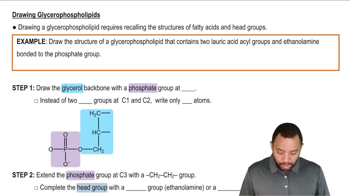Identify the following features of this phospholipid, which is needed for the brain and nerve tissues:
a. Is the phospholipid formed from glycerol or sphingosine?
 Verified step by step guidance
Verified step by step guidance Verified video answer for a similar problem:
Verified video answer for a similar problem:



 2:5m
2:5mMaster Glycerophospholipids Concept 1 with a bite sized video explanation from Jules
Start learning